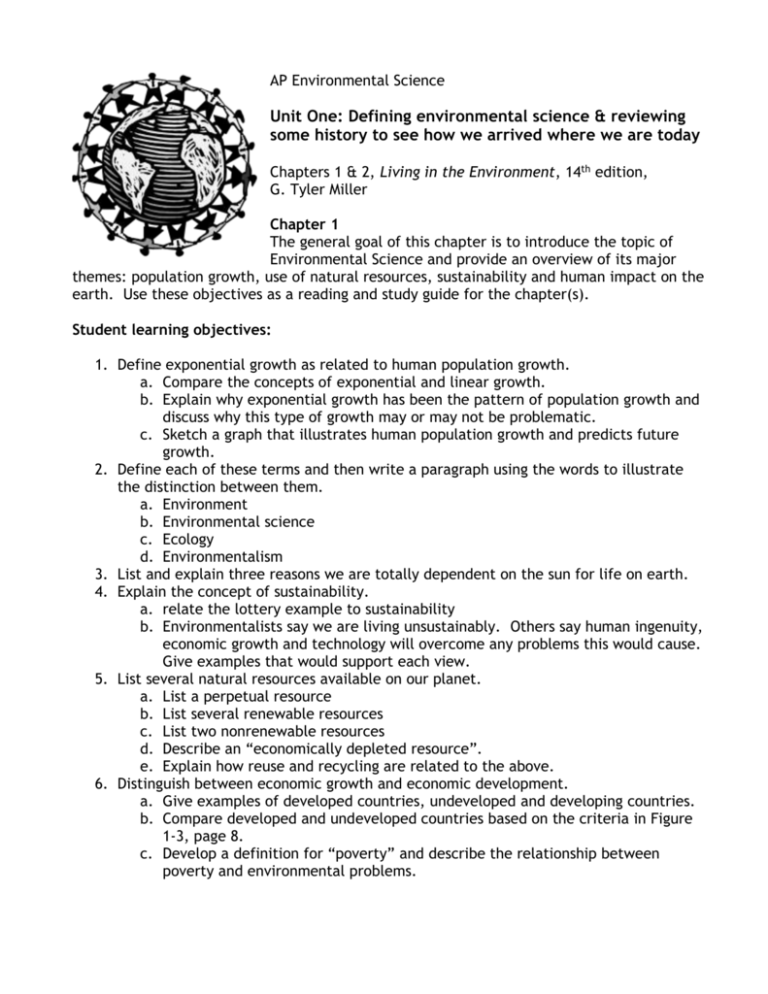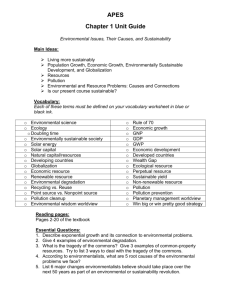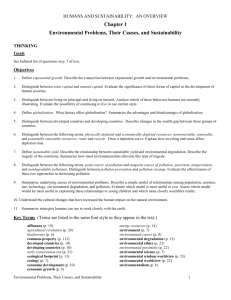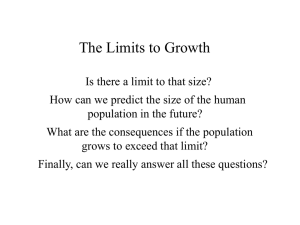AP Environmental Science
advertisement

AP Environmental Science Unit One: Defining environmental science & reviewing some history to see how we arrived where we are today Chapters 1 & 2, Living in the Environment, 14th edition, G. Tyler Miller Chapter 1 The general goal of this chapter is to introduce the topic of Environmental Science and provide an overview of its major themes: population growth, use of natural resources, sustainability and human impact on the earth. Use these objectives as a reading and study guide for the chapter(s). Student learning objectives: 1. Define exponential growth as related to human population growth. a. Compare the concepts of exponential and linear growth. b. Explain why exponential growth has been the pattern of population growth and discuss why this type of growth may or may not be problematic. c. Sketch a graph that illustrates human population growth and predicts future growth. 2. Define each of these terms and then write a paragraph using the words to illustrate the distinction between them. a. Environment b. Environmental science c. Ecology d. Environmentalism 3. List and explain three reasons we are totally dependent on the sun for life on earth. 4. Explain the concept of sustainability. a. relate the lottery example to sustainability b. Environmentalists say we are living unsustainably. Others say human ingenuity, economic growth and technology will overcome any problems this would cause. Give examples that would support each view. 5. List several natural resources available on our planet. a. List a perpetual resource b. List several renewable resources c. List two nonrenewable resources d. Describe an “economically depleted resource”. e. Explain how reuse and recycling are related to the above. 6. Distinguish between economic growth and economic development. a. Give examples of developed countries, undeveloped and developing countries. b. Compare developed and undeveloped countries based on the criteria in Figure 1-3, page 8. c. Develop a definition for “poverty” and describe the relationship between poverty and environmental problems. 7. Define the term globalization. a. Explain how air travel, telephones, mass media and the internet have contributed to globalization. b. Describe what you think is good about globalization and what is bad about it. c. Describe how globalization has affected you and your peer group. 8. Describe the “Tragedy of the Commons” as defined by Garrett Hardin in 1968 and explain how you are either a player or not. 9. Define the term pollution. a. Add the terms anthropogenic, point source and non point source to your definition. b. Distinguish between pollution prevention and pollution clean-up and give an example of each. c. Identify a situation where pollution prevention makes more sense than pollution clean-up. 10. List the “Big Five” environmental problems. a. Identify the problem that you think is the most serious and explain why. b. Identify the problem you think would be the easiest to tackle and explain why. c. Identify the problem you think would be the most difficult to solve and explain why. 11. List the necessities poor people tend to lack access to as in Figure 1-11 on p. 13. a. Explain why the lack of each necessity would contribute to a lower life expectancy. b. Comment on your access to each of these basic necessities and how this affects your life and lifestyle. 12. Describe the disease of Affluenza. a. Explain whether you think this disease is a problem or not. b. Comment on your personal level of infection (or lack of) with this disease. 13. Explain the model I = P x A x T. Make sure to define each variable. a. Compare I for the U.S. to I for an undeveloped country. b. Explain how this model is oversimplified. 14. Contrast the “technical optimist” with the “environmental pessimist”. a. Describe where your personal beliefs put you on this continuum. b. Describe where your parents’ beliefs put them on this continuum. 15. Describe your personal worldview. Relate your answer to objective 14. 16. List the six greatest environmental problems we face as given on p. 17, in a table form. Make a two column table. a. Using figure 10 on page 13, match the problems with the causes. You may match more than one cause with each problem. b. Be prepared to justify your choices. 17. Describe the meaning of “environmentally sustainable economic development” with two examples. Chapter 2 The general goal of this chapter is to summarize man’s history on earth with respect to environmental concerns. Major figures in the environmental movement, including politicians are introduced to the students. Student Learning Objectives 1. Describe how Native Americans depended on bison, yet did not disrupt the bison population. Contrast that with the events that led to near extinction of this animal species. 2. State the three major human cultural changes that have lead to changes in our natural environment. Explain how each change impacted the environment. 3. Explain why most Native American groups had a low impact on their natural environment and how the frontier environmental view differed from theirs. 4. Construct a timeline to order these environmentalists and briefly describe their contributions to conservation and the environmental movement. Henry David Thoreau, George P. Mark, John Muir, Rachel Carson, Aldo Leopold, Theodore Roosevelt, Gifford Pinchot, Gaylord Nelson, Al Gore. 5. Construct a table to summarize the environmental legislation listed in chapter 2 of our text. a. List the name of each act, year enacted and the basic protection. b. Pick the act you think was the most important and support your choice. 6. Explain how the Depression may have been good for the environment. Describe the positive actions of the Civilian Conservation Corps. 7. Describe the spaceship earth environmental worldview. 8. Compare and contrast the Sagebrush Rebellion with the Wise-Use Movement. 9. Construct a four column table to summarize the environmental contributions (or lack there of) of the U.S. presidents listed in text chapter 2. a. List the president’s name b. Years in office c. Identify each man as “pro-environment or anti-environment” d. Provide the reason for your identification as above. e. Where does Barack Obama stand on environmental issues?





